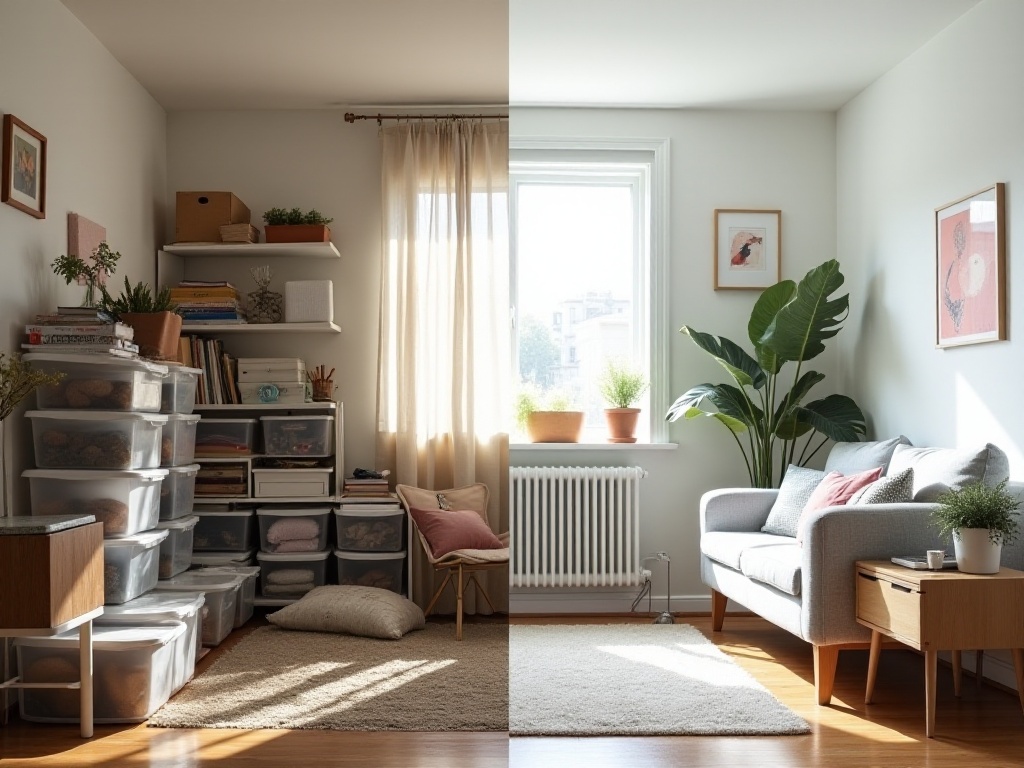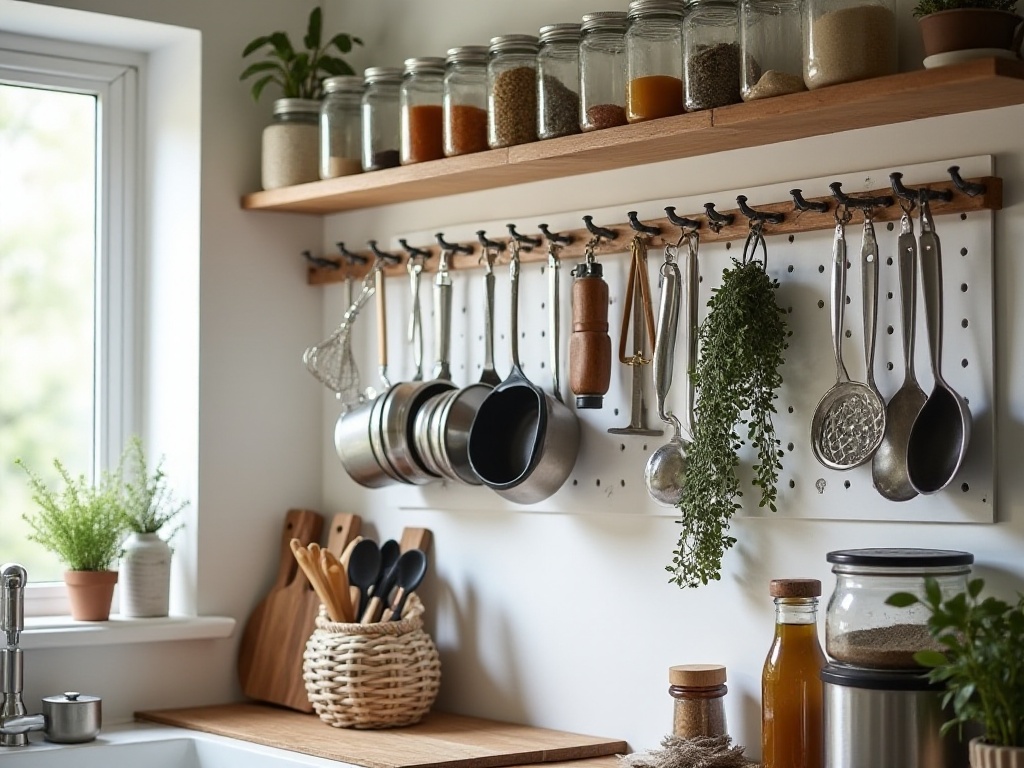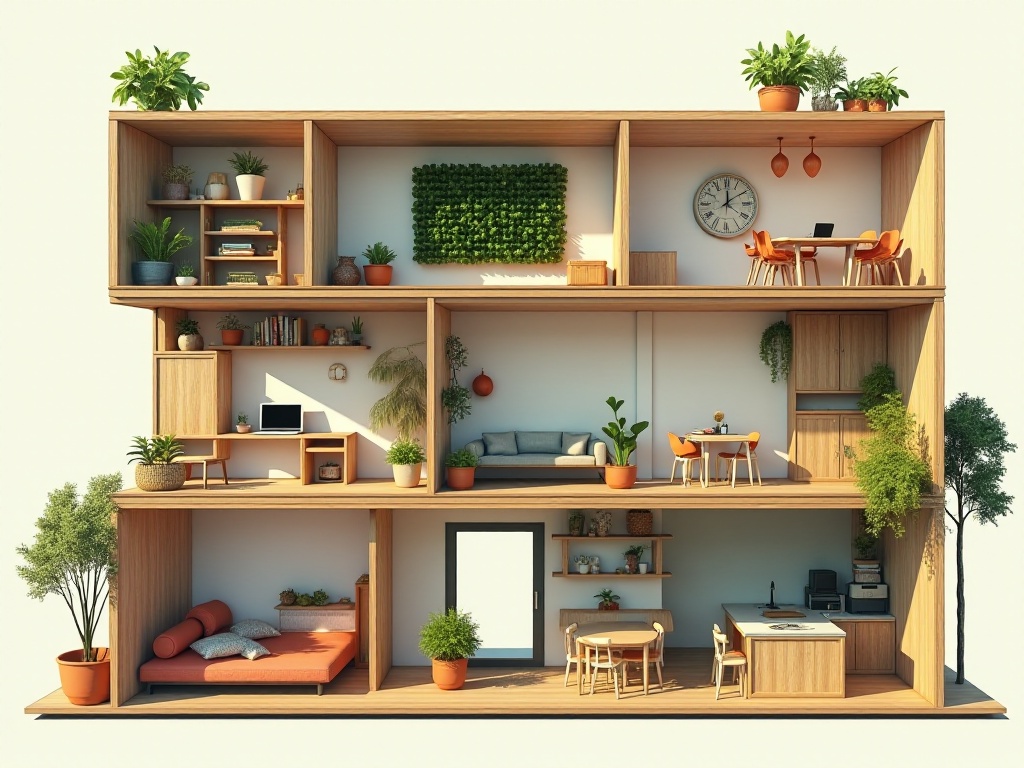
Introduction
I am an ordinary working professional who has been living in rented apartments for exactly ten years. I remember when I first started working, I would get overwhelmed every time I looked at my small, messy kitchen, often giving up on cooking and ordering takeout instead. After years of exploration and experimentation, I finally found an extremely practical kitchen storage solution, and today I'd like to share my experiences with everyone.
Space Planning
When it comes to kitchen storage, space planning is actually the most crucial aspect. I specifically sought advice from an experienced interior designer who shared a lot of professional knowledge with me. The most memorable was the "work triangle" theory. While this theory sounds professional, it simply means arranging the three most frequently used areas - sink, stove, and refrigerator - in a way that forms a convenient triangle for movement.
According to research by the International Interior Design Association, the distance between these three areas should ideally be between 1.2 and 2.7 meters. This distance was determined through extensive data analysis, ensuring convenient movement while cooking without wasting time due to excessive distances. After reorganizing my kitchen according to this standard, the results were particularly noticeable, and cooking efficiency improved significantly.
Besides the work triangle, space planning also needs to consider storage zone division. I divided my kitchen into three main areas: prep area, cooking area, and cleaning area. The prep area mainly holds cutting boards, mixing bowls, and seasonings; the cooking area is around the stove, storing pots and aprons; the cleaning area is near the sink, holding cleaning supplies and dishcloths. After this zoning, cooking became much more organized, and I no longer had to search everywhere for things like before.

Storage Principles
When it comes to storage principles, the most important thing is learning to utilize vertical space. I've observed many people's kitchens and found that most only focus on cabinet and countertop storage while ignoring the super practical wall space. Actually, wall space is the "golden zone" for kitchen storage - proper utilization can instantly increase storage space by over 40%.
I installed many storage solutions on my walls. For example, magnetic strips can hold various metal utensils; hooks can hang spatulas and aprons; wall-mounted shelves can store seasonings and small plants. These storage items aren't expensive but are extremely practical. I also installed an expandable dish rack above the sink, providing a space-efficient spot for draining washed dishes and utensils.
Zone-based storage is also a crucial principle. I categorized seasonings into three groups based on frequency of use: daily items like salt and soy sauce are placed in the most accessible positions; frequently used but not daily items like five-spice powder and cooking wine are in secondary positions; rarely used items like special seasonings are placed on higher shelves. After this categorization, cooking became much more convenient, and I no longer need to search through everything to find what I need.

Practical Techniques
Now let's discuss specific storage techniques. First is utilizing corner spaces, which I consider my special expertise. Kitchens always have some awkward corners that are hard to use, especially corner cabinets where space often goes to waste. I installed rotating storage racks in these areas, transforming dead corners into super practical storage spaces.
There are many types of corner storage racks available in the market. Cheap ones can be bought for just tens of dollars, while expensive ones might cost hundreds. I chose a mid-range one for 128 yuan, with good quality and practicality. This storage rack can rotate 360 degrees, making it very convenient to access items, and it has strong weight-bearing capacity, suitable for storing pots or large kitchen items.
The second technique is drawer dividers. I bought a set of drawer dividers on Taobao for just 30 yuan, but the effect is excellent. These dividers can be freely combined according to needs. I divided the drawer into different-sized compartments for storing cutlery, seasonings, and small kitchen tools. Now everything in the drawers is neat and organized instead of being a mess.
Another particularly useful technique is using hanging storage. I installed a long mounting rail on the kitchen wall where various storage baskets and hooks can be hung. This not only fully utilizes wall space but also makes items easy to access. I also bought some suction cup hooks that can attach to tiles, used for hanging dishcloths and aprons.
Cost Control
Many people might worry that storage improvements will be expensive, but there's no need to worry. I recorded all my storage improvement expenses:
The wall-mounted shelf cost 89 yuan, bought online, made of stainless steel, waterproof and rust-resistant, with strong load-bearing capacity. The magnetic knife holder was 35 yuan, can hold various metal utensils, very practical. Drawer dividers were 30 yuan, though cheap, the quality is good and they've lasted a long time. The hook storage system was 45 yuan, including a long mounting rail and various hook accessories. The corner storage rack was 128 yuan, my most expensive storage purchase, but absolutely worth the price as it utilizes corner space extremely well.
These storage items totaled only 327 yuan but completely transformed my kitchen. A well-organized kitchen not only improves cooking efficiency but also enhances mood. Every time I walk into my neat and orderly kitchen, I feel inspired to cook.

Usage Experience
After such a long time of practice, I deeply appreciate how important a good storage system is for quality of life. Previously, I would spend nearly an hour making a meal, with much time spent just finding things. Now with these storage solutions, I can prepare a hearty dinner in 40 minutes, significantly improving efficiency.
Moreover, a neat kitchen really inspires cooking enthusiasm. I remember once when I invited a colleague over for dinner, she exclaimed upon entering the kitchen: "Wow, your kitchen is so organized, it doesn't look like a rental at all!" Hearing such praise was really satisfying.
Through proper storage, I've at least doubled my kitchen space utilization. I used to think my kitchen was too small to hold everything, but now I realize the storage method was wrong. Even the smallest kitchen can become well-organized if you know how to utilize space effectively.

Important Considerations
I want to particularly remind everyone of several important points. First, the choice of storage item materials is crucial. The kitchen is a special environment with lots of oil and moisture, so storage items must be water and oil resistant. Initially, I bought wooden storage boxes to save money, but they became moldy and warped after short use and had to be thrown away and replaced. Later, I switched to food-grade plastic and stainless steel storage items - though more expensive, they're much more durable.
Second, arrange items according to frequency of use. I observed my cooking habits and placed daily-use items like common seasonings and spatulas within easy reach. Less frequently used items can be placed higher or further away. This saves time and reduces unnecessary bending and reaching.
Third, regularly clean and maintain the storage system. Even the best storage solution will become chaotic without timely organization and maintenance. I set aside time each month to thoroughly organize the kitchen, throwing out what needs to be discarded and adjusting what needs adjustment, to maintain the storage system's efficiency.
Summary and Reflections
Through these years of exploration and practice, I deeply understand that kitchen storage isn't something achieved overnight but a process requiring continuous adjustment and optimization through daily use. Everyone has different usage habits and family structures, so suitable storage solutions will differ. My current storage system was developed through countless failures and improvements.
According to a quality of life survey, over 70% of young urban dwellers reduce their cooking frequency due to kitchen clutter. This statistic resonates deeply with me. Cooking should be an enjoyable activity, but a constantly messy kitchen definitely affects mood. Therefore, a good storage system not only improves life efficiency but also enhances quality of life.
Through years of practice, I've summarized several important storage principles: first, fully utilize vertical space, turning walls into storage areas; second, plan storage locations based on usage frequency and movement patterns; third, choose appropriate storage items, considering materials and practicality; fourth, regularly maintain and optimize the storage system.

Future Outlook
With technological development, kitchen storage methods continue to innovate. Some smart storage solutions have already appeared in the market, such as shelves that automatically adjust height based on usage frequency, and seasoning storage systems with temperature control features. These new technologies make kitchen storage more convenient and user-friendly.
However, I believe that no matter how technology develops, the basic principles of reasonable space utilization will never become outdated. A good storage solution should be practical, economical, and easy to maintain - these are the most important aspects. I hope my sharing can help everyone create a well-organized kitchen space. Let's look forward to more possibilities in kitchen storage and create better home living.
Next
Starting from a Tang Yuan: Do You Really Understand the Chinese Wisdom in the Lantern Festival?
Explore Chinese traditional festival customs and life wisdom, covering cultural activities, food traditions, and celebrations of Spring Festival, Dragon Boat Festival, Lantern Festival, and Mid-Autumn Festival, along with practical tips for improving life efficiency and home organization
Ten Years as a Working Professional: 14 Kitchen Storage Tips to Double Your Kitchen Space
A comprehensive guide exploring life hacks and festival customs, covering practical home organization tips, kitchen techniques, and traditional customs exemplified through Chinese New Year celebrations and cultural heritage practices
No More Kitchen Cleaning Struggles! These Practical Tips Will Make Your Kitchen Look Brand New
A comprehensive guide to practical life hacks and traditional festival customs, covering kitchen techniques, cleaning methods, clothing care, storage tips, and cultural practices of traditional festivals like Mid-Autumn Festival and Lantern Festival
Next

Starting from a Tang Yuan: Do You Really Understand the Chinese Wisdom in the Lantern Festival?
Explore Chinese traditional festival customs and life wisdom, covering cultural activities, food traditions, and celebrations of Spring Festival, Dragon Boat Festival, Lantern Festival, and Mid-Autumn Festival, along with practical tips for improving life efficiency and home organization

Ten Years as a Working Professional: 14 Kitchen Storage Tips to Double Your Kitchen Space
A comprehensive guide exploring life hacks and festival customs, covering practical home organization tips, kitchen techniques, and traditional customs exemplified through Chinese New Year celebrations and cultural heritage practices

No More Kitchen Cleaning Struggles! These Practical Tips Will Make Your Kitchen Look Brand New
A comprehensive guide to practical life hacks and traditional festival customs, covering kitchen techniques, cleaning methods, clothing care, storage tips, and cultural practices of traditional festivals like Mid-Autumn Festival and Lantern Festival

